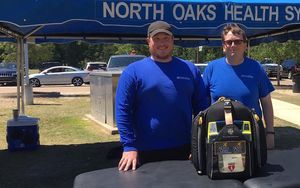
Article reposted from The Daily Star
Author: CALEB LAY
On his first day of college classes, Nathan Borget found himself preparing water bottles and equipment for the East Carolina University’s women’s basketball team at 4:30 a.m.
“Do I really want to do this?” he thought. Borget was there because he decided to be an athletic training major.
He picked his college major, and his career, by accident. After a high school injury introduced him to sports medicine, he decided to study athletic training because he thought he’d get to be a strength coach and help athletes get bigger, stronger, faster and in better shape.
His first night on ECU’s campus himself and the other freshmen athletic training majors had a meeting that clarified what they would be doing and which sport they would work with for the year.
“I was mind-blown,” Borget said. But he got up early in the morning, helped get practice ready and fell in love with sports medicine.
He currently serves as the head athletic trainer for North Oaks Health System in Hammond. Now he works with a lot of high school student-athletes thanks to the partnership between Tangipahoa Parish schools and most Livingston Parish Schools.
Borget understands that healing people, especially athletes, takes more than just drilling them through the physical protocols. A good athletic trainer will work on healing their mind and help them gain the confidence to get back on the field without lingering fears or doubts of getting reinjured.
The second we sat down to talk he started asking me questions to get a feel for how much I knew about the aspects of his job. The way he displayed open body language and spoke in a softer, soothing voice made me subconsciously start explaining a shoulder surgery and the rehab protocol I had to go through to get back to playing sports.
“Wait a second,” I said after talking about my rehab process. “You’re interviewing me now.”
“It’s good to know who you’re talking to,” he said calmly after a chuckle. “Now I know we can talk about therapy and treament on a different level than if you knew nothing.” That’s Borget — aware of how to make people comfortable and likes figuring out how best to talk and work with them.
It’s that openness and desire to help people regardless if it’s a sprained ankle or helping a reporter get all the information they need that makes Borget analyze the people around him for ailments or bruises.
“I always catch myself watching for the feet that are collapsing or the knees that are in or they’re not really walking but they’re waddling, or they’re using their back to bend down instead of their legs,” Borget said. “So I become a nerd when it comes to our conventions and ask a bunch of questions about that stuff.”
However, his favorite part of the job is watching an athlete get back on the field after rough injuries. He always has the same story come to his head when asked what his favorite case is.
“When I was in grad school we had an athlete break their femur during an event,” Borget said. “It was crazy. He said, ‘I ran two more steps before I collapsed.'”
When Borget started working with him, he was in a bad emotional state. When an injury occurs, there is typically a cycle of grief, minus the bargaining. First, the athlete goes through denial and thinks they can play through the pain, but, eventually, they realize they can’t. This leads to depression and eventually anger before the athlete accepts the injury and can mentally move forward.
“He was stuck between angry and depressed,” Borget said. “It took three or four months of really working with him and reached small milestones to work him up to where he was engaged coming in every day. I can still picture the first time he was running across the field at practice with no limp.” After he told the story, he smiled and shook his head.
Borget has come a long way since that morning as a freshman in college wondering, “Do I really want to do this?” Now, it’s difficult for him to imagine doing something else with his life.
“There will always be long hours,” he said. “But the benefits of treating an athlete — I’m kind of getting goosebumps right now thinking about them getting back on the field for the first time without a limp — and seeing them reaching that goal or getting picked up by a college team is immeasurable.

